Confucianism › Confucius › A Ghost Story of Ancient Egypt » Origins and History
Articles and Definitions › Contents
- Confucianism › Origins
- Confucius › Who Was
- A Ghost Story of Ancient Egypt › Origins
Ancient civilizations › Historical places, and their characters
Confucianism › Origins
Definition and Origins
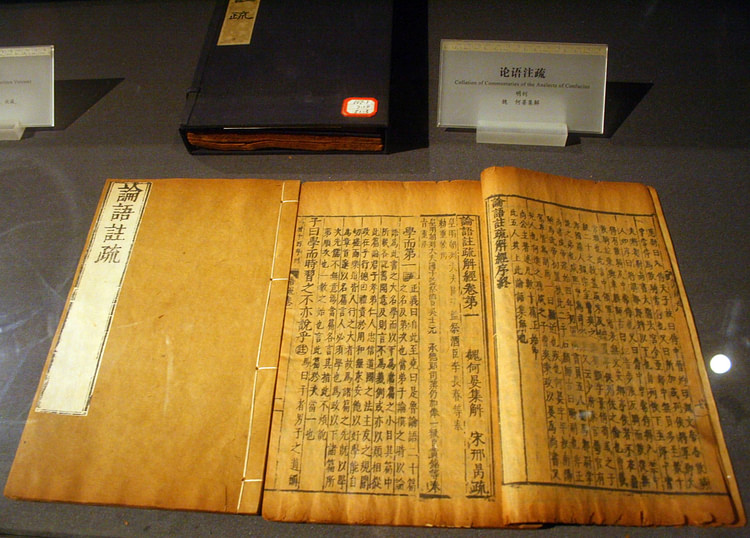
The philosopher Confucius (or Kongzi, c. 551 to c. 479 BCE) is the recognized founder of Confucianism, also referred to as the Ru-jia doctrine or School of Literati as it is known by Western scholars. Originally, Confucianism was composed of a set of political and moral doctrines with the teachings of Confucius as its basis. Later on, the teachings of Mencius (Meng Zi) and Xunzi (Xun zi) also became part of Confucianism. The word Confucianism seems to be the creation of European Christians who entered China about 1860 CE and was originally used to label their notion of the non-Christian religions they came across in China.
THE APPROACH & TEACHINGS OF CONFUCIUS
While his neighbours in India were obsessed with metaphysical debates, Confucius was solely focused on everyday concerns.He was indifferent to the big mysteries of existence such as the origin or the universe, god or the afterlife. His famous answers to this type of question were:
We do not yet know how to serve man, how can we know about serving the spirits?We don't know yet about life, how can we know about death?
Humanism is the central feature of Confucianism, which revolves almost entirely around issues related to the family, morals, and the role of the good ruler. It stresses the need for benevolent and frugal rulers, the importance of inner moral harmony and its direct connection with harmony in the physical world. Rulers and teachers, according to this view, are important models for society: a good government should rule by virtue and moral example rather than by punishment or force. Filial piety and ancestor worship, which are old traditional Chinese values, are also part of the key components of Confucian doctrine.
THE ATTENTION OF CONFUCIUS WAS ATTRACTED TOWARDS VERY PRACTICAL CONSIDERATIONS OF THIS WORLD RATHER THAN SEEKING CONSOLATION IN OTHERWORLDLY NOTIONS.
Confucius believed in the perfectibility of all men and he was against the idea that some men are born superior to others.During his time it was held that nobility was a quality determined by status and that belonging to a specific social circle made a person morally superior. Confucius challenged this idea by saying that being morally superior had nothing to do with the blood, rather, it was a matter of character and personal development, a revolutionary concept at that time.
THE ORIGINS OF CONFUCIANISM
To ignore the mysteries of life is the price Confucius had to pay to focus his energy on this world. It is often claimed that there is a lack of imagination in Confucianism, that it is a philosophy reluctant to imagine the new, to embrace changes and innovations. The Confucian indifference to the big mysteries, whether cause or effect of the lack of imagination, seems to be the only approach consistent with the time when Confucius developed his thought, a time when there was political struggle, moral chaos, and intellectual conflict, in short, when order was almost non-existent. Confucius thought that going back to the traditional ways was the only path for society to get back on track. He lived during a time when the Zhou dynasty was immersed in serious political conflicts.
The attention of Confucius was attracted towards very practical considerations of this world rather than seeking consolation in otherworldly notions. He decided to seek a solution for the challenges of his time, a way to cure a society which, nearly everyone agreed, was sick. He often mentions some of the sage-emperors of the past: Emperor Yao (a legendary ruler of the 3rd century BCE), his successor Emperor Shun and the Duke of Zhou, who were considered responsible of establishing the foundations of Chinese culture. These were considered by Confucius as inspiring models for a society, far more useful than supernatural beings or other metaphysical ideas.
CONFUCIANISM & THE STATE
The teachings of Confucius have come down to our days through his Analects, a collection of aphorisms, maxims and different anecdotes, probably but not certainly compiled by Confucius' students. It was during the Han dynasty (206 BCE-220 CE) when Confucianism became the dominant political ideology and the Analects became known by that name. All early versions of this text have been displaced by a version compiled near the end of the Han dynasty. About 175 CE this version was carved on stone tablets and the surviving fragments of those stones were re-edited innumerable times. Despite the fact that it is not entirely certain whether the Analects truly contain the message of Confucius, it is generally accepted that it is the most reliable source of Confucius' view.
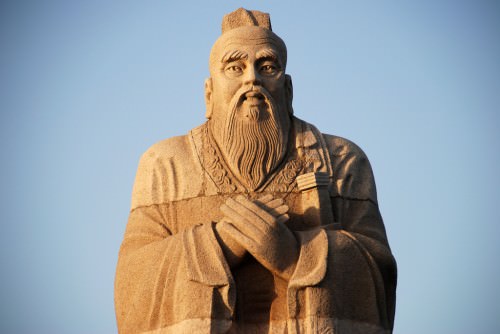
Confucius
Confucianism was not always popular during the Han dynasty. In fact, the first Han emperor Liu Bang, who ruled until 195 BCE, did not feel any respect at all for the Confucian school. The famous Chinese historian Sima Qian tells us that whenever Liu Bang identified a Confucian (an easy thing to do because they used to wear a very distinctive pointed hat), " immediately snatches the hat from the visitor's head and pissed in it”. It was later on during the time of Emperor Wu (r. 141-87 BCE) that the Confucian school received the support of the Chinese rulers and gradually became the official state philosophy. Thousands of academies spread the Confucian ideology across the Chinese empire and from here it travelled to most of East Asia.
The support that Confucianism received during the late Han period was the opposite of what had happened earlier on during the Qin dynasty (221-206 BCE), when the Emperor Qin Shi Huang ( Shi Huangti, 259-210 BCE) got tired of the critics his government received from Confucian scholars by comparing it with previous dynasties. Qin Shi Huang decided to do something about it, he wrote, "I suggest that the official histories, with the exception of the Memoirs of Qin, be all burnt, and that those who attempt to hide [other works] be forced to bring them to the authorities to be burnt." (Durant, 697).
Quin Shi Huan banned Confucianism along with all other schools, except for the Legalist school or Fa-jia, which was the official government philosophy. Freedom of speech was suppressed, hundreds of Confucian scholars were buried alive and several classic Chinese texts were burnt.
THE ANALECTS
Around 1190 CE, the Analects became part of a collection of four books that until 1905 CE were the subject of the Chinese civil service examinations. It was the Neo-Confucian philosopher Zhu Xi (Chu Hsi) who gave to these texts authoritative status.The other three texts were the Book of Mencius, the Great Learning, and the Doctrine of the Mean.

Confucius by Wu Daozi
As has happened with the teachings of every great mind of antiquity, some ideas of Confucius have been subject to reinterpretation. We can take, for example, one of his statements that men are alike by nature, and they become apart through practice ( Analects, 17:2). This idea on human nature is slightly different from what the later orthodox Confucian school said, that human nature is originally good.
The Analects is not written in systematic way but rather in a poetic way that sometimes can be interpreted in different ways.These are some examples of its passages where Confucius said:
Wealth and honour are what every man desires. But if they have been obtained in violation of moral principles, they must not be kept. Poverty and humble station are what every man dislikes. But if they can be avoided only in violation of moral principles, they must not be avoided. A superior man never abandons humanity even for the lapse of a single meal. In moments of haste, he acts according to it. In times of difficulty or confusion, he acts according to it. ( Analects 4:5)The superior man wants to be slow in word but diligent in action. ( Analects 4:24)I transmit but do not create. I believe in and the love of the ancients. I venture to compare myself to our old Peng.( Analects 7:1)
[Old Peng Wan an official of the Shang dynasty (c. 1600-1046 BCE) who was known for reciting old stories.This fragment is sometimes cited to point out that Confucius was not creative. However, we read in the Analects2:11 that Confucius “goes over the old so as to find out what is new".]When Tzu kung asked about government, Confucius said: "Sufficient food, sufficient armament, and sufficient confidence of the people.” Tzu kung said, “Forced to give up one of these, which would you abandon first?” Confucius said, “I would abandon the armament.” Tzu kung said, “Forced to give up one of the remaining two, which would you abandon first?” Confucius said, “I would abandon food. There have been deaths from time immemorial, but no state can exist without the confidence of the people.” ( Analects 12:7)If a ruler sets himself right, he will be followed without his command. If he does not set himself right, even his command will not be obeyed. ( Analects 13:6)
LEGACY
The humanistic turn in Chinese philosophy is due to the enormous influence of Confucianism and it is humanism that is the most outstanding feature of Chinese philosophy as a whole. During most of Chinese history, Confucianism was seen as the preserver of traditional Chinese values, the guardian of Chinese civilization as such. After struggling during the Qin dynasty, it emerged as the final and permanent victor during the later Han period and would dominate Chinese thought ever after.
Confucius › Who Was
Definition and Origins
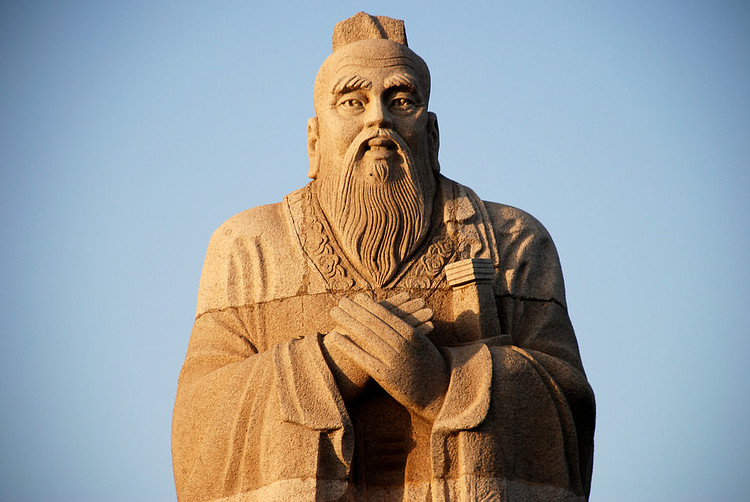
Confucius (or Kongzi) was a Chinese philosopher who lived in the 6th century BCE and whose thoughts, expressed in the philosophy of Confucianism, have influenced Chinese culture right up to the present day. Confucius has become a larger than life figure and it is difficult to separate the reality from the myth. He is considered the first teacher and his teachings are usually expressed in short phrases which are open to various interpretations. Chief among his philosophical ideas is the importance of a virtuous life, filial piety and ancestor worship. Also emphasised is the necessity for benevolent and frugal rulers, the importance of inner moral harmony and its direct connection with harmony in the physical world and that rulers and teachers are important role models for wider society.
CONFUCIUS' EARLY LIFE
Confucius is believed to have lived from c. 551 to c. 479 BCE in the state of Lu (now Shandong or Shantung). However, the earliest written record of him dates from some four hundred years after his death in the Historical Records of Sima Qian (or Si-ma Ts'ien). Raised in the city of Qufu (or K'u-fou), Confucius worked for the Prince of Lu in various capacities, notably as the Director of Public Works in 503 BCE and then the Director of the Justice Department in 501 BCE. Later, he travelled widely in China and met with several minor adventures including imprisonment for five days due to a case of mistaken identity.Confucius met the incident with typical restraint and was said to have calmly played his lute until the error was discovered.Eventually, Confucius returned to his hometown where he established his own school in order to provide students with the teachings of the ancients. Confucius did not consider himself a 'creator' but rather a 'transmitter' of these ancient moral traditions. Confucius' school was also open to all classes, rich and poor.
CONFUCIANISM BECAME THE OFFICIAL STATE RELIGION OF CHINA FROM THE 2ND CENTURY BCE.
CONFUCIUS' WORKS
It was whilst he was teaching in his school that Confucius started to write. Two collections of poetry were the Book of Odes(Shijing or Shi king) and the Book of Documents (Shujing or Shu king). The Spring and Autumn Annals (Lin Jing or Lin King), which told the history of Lu, and the Book of Changes ( Yi Jing or Yi king) was a collection of treatises on divination.Unfortunately for posterity, none of these works outlined Confucius' philosophy. Confucianism, therefore, had to be created from second-hand accounts and the most reliable documentation of the ideas of Confucius is considered to be the Analectsalthough even here there is no absolute evidence that the sayings and short stories were actually said by him and often the lack of context and clarity leave many of his teachings open to individual interpretation. The other three major sources of Confucian thought are Mencius, Great Learning and Mean. With Analects, these works constitute the Four Books of Confucianism otherwise referred to as the Confucian Classics. Through these texts, Confucianism became the official state religion of China from the second century BCE.
CONFUCIANISM
Chinese philosophy, and particularly Confucianism, has always been concerned with practical questions of morality and ethics. How should man live in order to master his environment, provide suitable government and achieve moral harmony?Central to Confucianism is that the moral harmony of the individual is directly related to cosmic harmony; what one does, affects the other. For example, poor political decisions can lead to natural disasters such as floods. An example of the direct correlation between the physical and the moral is evidenced in the saying, 'Heaven does not have two suns and the people do not have two kings'. A consequence of this idea is that, just as there is only one cosmic environment, there is only one true way to live and only one correct political system. If society fails it is because sacred texts and teachings have been misinterpreted; the texts themselves contain the Way but we must search for and find it.

Confucius by Wu Daozi
Another important facet of Confucius' ideas was that teachers, and especially rulers, must lead by example. They must be benevolent in order to win the affections and respect of the populace and not do so by force, which is futile. They should also be models of frugality and high moral upstanding. For this reason, Chinese education has often favoured the cultivation of moral sensibilities rather than specific intellectual skills. Further, under Confucian influence, Chinese politics principally focussed on the intimacy of relationships rather than institutions.
MENCIUS & XUNZI
The thoughts of Confucius were further developed and codified by two important philosophers, Mencius (or Mengzi) and Xunzi (or Hsun Tzu). Whilst both believed that man's sense of morality and justice separated him from the other animals, Mencius expounded the belief that human nature is essentially good whilst Xunzi, although not of an opposite position, was slightly more pessimistic about human nature and he, therefore, stressed the importance of education and ritual to keep people on the right moral track.
Confucianism, therefore, expounded the importance of four virtues which we all possess: benevolence ( jen ), righteousness ( i), observance of rites ( li ) and moral wisdom ( te ). A fifth was later added - faith - which neatly corresponded to the five elements (in Chinese thought) of earth, wood, fire, metal and water. Once again, the belief that there is a close link between the physical and moral spheres is illustrated. By stating that all men have such virtues, two ideas are consequent: education must nurture and cultivate them and all men are equal - 'Within the four seas all men are brothers'. With suitable application, anyone can become a sage ( sheng ). It is not innate talent which is important but one's will to mould one's character into the most virtuous possible.
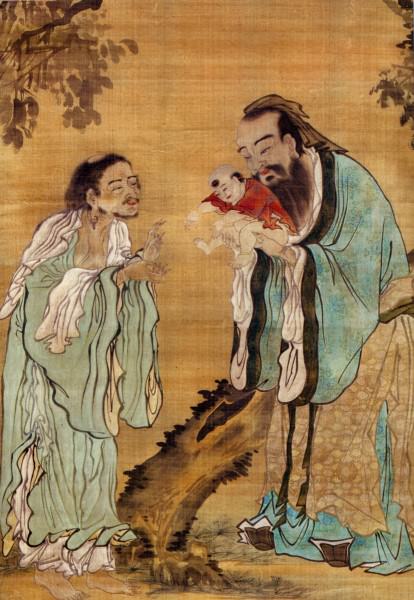
Confucius, Buddha and Lao-Tzu
LEGACY
Following his death in 479 BCE, Confucius was buried in his family's tomb in Qufu (in Shandong) and, over the following centuries, his stature grew so that he became the subject of worship in schools during the Han Dynasty (206 BCE-220 CE) and temples were established in his name at all administrative capitals during the Tang Dynasty (618-907 CE). Throughout the imperial period an extensive knowledge of the fundamental texts of Confucianism was a necessity in order to pass the civil service selection examinations. Educated people often had a tablet of Confucius' writings prominently displayed in their houses and sometimes also statues, most often seated and dressed in imperial costume to symbolise his status as 'the king without a throne'. Portrait prints were also popular, especially those taken from the lost original attributed to Wu Daozi (or Wu Taoutsi) and made in the 8th century CE. Unfortunately, no contemporary portrait of Confucius survives but he is most often portrayed as a wise old man with long grey hair and moustaches, sometimes carrying scrolls.
The teachings of Confucius and his followers have, then, been an integral part of Chinese education for centuries and the influence of Confucianism is still visible today in contemporary Chinese culture with its continued emphasis on family relationships and respect, the importance of rituals, the value given to restraint and ceremonies, and the strong belief in the power and benefits of education.
A Ghost Story of Ancient Egypt › Origins
Ancient Civilizations
The best-known ghost story from ancient Egypt is known, simply, as A Ghost Story but sometimes referenced as Khonsemhab and the Ghost. The story dates from the late New Kingdom of Egypt (c. 1570 - c.1069 BCE) and specifically the Ramesside Period (1186-1077 BCE). It was found in fragments on ostraca ( pottery with writing on it) which scholars such as Georges Posener (in 1960 CE) and Jurgen von Beckerath (in 1992 CE) claim are copies of a much older story from the Middle Kingdom of Egypt (2040-1782 BCE). This would make sense as the traditional view of the afterlife in Egypt as a paradise was often questioned in texts from that era (such as The Lay of the Harper or A Dispute Between a Man and his Soul), and Khonsemhab reflects this view in his conversation with the ghost.

Khonsemhab and the Ghost
A Ghost Story tells the tale of the High Priest of Amun Khonsemhab and his encounter with a restless ghost whose tomb has deteriorated. The story exists on four ostraca discovered in and around the necropolis of Deir el-Medina near Thebesbetween c. 1880 CE and 1905 CE. These ostraca today are housed in museums in Paris, Florence, Vienna, and Turin and each one relates another section of the story. The conclusion of the tale, unfortunately, has not yet been found.
As is the case with ghost stories from around the world, the Khonsemhab tale operates on two levels: entertainment and cultural education. An audience would have been entertained while at the same time receiving instruction on the importance of honoring the dead by caring for their final resting places.
THE STORY
Scholars differ on interpreting the text. Some claim it is a first-person narration by a speaker who spends the night in the necropolis at Thebes and encounters an angry spirit. This nameless narrator then goes to the high priest to seek his help and Khonsemhab raises the spirit to talk to it. The first-person narrator interpretation rests entirely on one of the early lines. Other scholars claim it is a third-person narration which tells how Khonsemhab encountered the spirit in the necropolis and then dedicated himself to helping it find peace.
AS IS THE CASE WITH GHOST STORIES FROM AROUND THE WORLD, THE KHONSEMHAB TALE OPERATES ON TWO LEVELS: ENTERTAINMENT AND CULTURAL EDUCATION.
The beginning of the story is as fragmentary as the conclusion which breaks off, so it is understandable how one concludes the "I" mentioned at the start indicates first-person narration. The story makes more sense as third-person omniscient narration, however, as no first-person narrator makes an appearance after the opening lines and these lines could, in fact, be dialogue spoken by Khonsemhab. Some translations, in fact, omit the "I" in the opening lines entirely, attributing them to Khonsemhab, without any effect on the story's cohesion.
Either way, after two lines which relate some sort of journey, Khonsemhab returns to his house and calls on the spirit to come to him and identify himself, promising to help him by building a new sepulcher and providing him "with all sorts of good things."It is clear that the high priest is already aware of the spirit's troubles. The ghost appears and says his name is Nebusemekh.Khonsemhab asks the spirit what is troubling him and Nebusemekh replies that his tomb has fallen and no one now remembers where he is buried so that proper offerings are no longer brought. Nebusemekh says he is "exposed in the wintry wind, hungry without food" and fears he may soon cease to exist or, as he puts it, "to overflow like the inundation" and be lost because his soul has no home to contain it.
Khonsemhab sits down next to the spirit and weeps for him in his sad state. The spirit then relates who he was in life:
When I was alive upon the earth I was overseer of the treasury of King Mentuhotep and I was lieutenant of the army, having been at the head of men and nigh to the gods. I went to rest in Year 14, during the summer months, of the King of Upper and Lower Egypt, Mentuhotep. He gave me my four canopic jars and my sarcophagus of alabaster and he had done for me all that is done for one in my position. He laid me to rest in my tomb with its shaft of ten cubits. See, the ground beneath has deteriorated and dropped away. The wind blows there and seizes the tongue. Now as for your having promised me `I shall have a sepulcher prepared anew for you' I have it four times already that it will be done in accordance with them. But what am I to make of the promises you have just made to me so that all these things may succeed in being executed? (Simpson, 113-114).
Khonsemhab assures the spirit that he will do everything he can for him saying, "Please express to me a fine commission such as is fit to be done for you and I will surely have it done for you," but the spirit is not convinced. Nebusemekh says, "Of what use are the things you would do? Unless a tree is exposed to sunlight, it does not sprout foliage," meaning that he does not expect the priest to be able to provide him with the kind of home he once had as Khonesemhab does not have those kinds of resources; just as a tree cannot blossom without sunlight, his tomb cannot be rebuilt on promises and goodwill. The priest has assured him already that, if he cannot build him a new tomb, he will have five men servants and five maidservants bring him food and water as offerings daily, but the spirit would not be consoled.
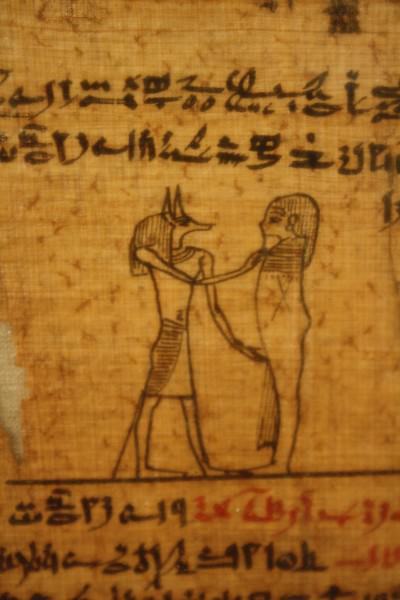
Book of the Dead (detail)
Nebusemekh disappears, but Khonsemhab does not forget what he has promised. He sends men to search for the ruined tomb, and they find it "twenty-five cubits distant along the king's causeway at Deir el-Bahri" and return to tell their master.Khonsemhab is pleased with this news and celebrates with the men and, afterwards, summons an official to tell him about the project. The story ends with the line "He returned in the evening to sleep in the Ne and he..." but the rest of the tale is lost. The "Ne" in the line refers to the necropolis at Thebes, and it is thought that Khonsemhab returns to where he was at the beginning of the story to tell Nebusemekh that he will soon have a new home.
THE TEXT
In the course of the tale here, one will find "lph" after a king's name. This is the English equivalent of the Egyptian phrase Ankh wedja seneb, meaning "life, prosperity, health," which appears after royal names in ancient inscriptions. The following text follows Beckerath's translation as reprinted in WK Simpson's The Literature of Ancient Egypt: An Anthology of Stories, Instructions, Stelae, Autobiographies, and Poetry. It omits the first-person narrator's line from the beginning of the story, "Now while I was looking toward the west, he went up onto the roof" which often appears in translations as the third line below.Ellipses throughout indicate missing words from the story while brackets and parentheses suggest probable words/sentences which are unclear in the original. The text reads:
[...according to] his habit...after the way he had done...He ferried across and reached his house. He caused [offerings to be] prepared saying, "I will provide him with all sorts of good things when I go to the west side." He went up onto the roof and he invoked the gods of the sky and the gods of the earth, southern, northern, western and eastern, and the gods of the underworld, saying to them: "Send me that august spirit." And so he came and said to him: "I am your...who has come to sleep during the night next to his tomb." Then the High Priest of Amun Khonsemhab said to him: "Please tell me your name, your father's name, and your mother's name that I may offer to them and do for them all that has to be done for those in their position." The august spirit then said to him: "Nebusemekh is my name, Ankhmen is my father's name, and Tamshas is my mother's name."Then the High Priest of Amun-Re, King of the Gods, Khonsemhab said to him; "Tell me what you want that I may have it done for you. And I shall have a sepulcher prepared anew for you and have a coffin of gold and zizyphus-wood made for you, and you shall [rest therein] and I shall have done for you all that is done for one who is in your position."The august spirit then said to him: "No one can be overheated who is exposed to wintry wind, hungry without food... It is not my desire to overflow like the inundation, not...not seeing my tomb... I would not reach it. There have been made to me promises..."Now after [he] had finished speaking, the High Priest of Amun-Re, King of the Gods, Khonsemhab, sat down and wept beside him with a face full of tears. And he addressed the spirit, saying, "How badly you fare without eating or drinking, without growing old or becoming young. Without seeing sunlight or inhaling northerly breezes. Darkness is in your sight every day. You do not get up early to leave."Then the spirit said to him: "When I was alive upon the earth I was overseer of the treasury of King Mentuhotep and I was lieutenant of the army, having been at the head of men and nigh to the gods. I went to rest in Year 14, during the summer months, of the King of Upper and Lower Egypt, Mentuhotep. He gave me my four canopic jars and my sarcophagus of alabaster and he had done for me all that is done for one in my position. He laid me to rest in my tomb with its shaft of ten cubits. See, the ground beneath has deteriorated and dropped away. The wind blows there and seizes the tongue. Now as for your having promised me `I shall have a sepulcher prepared anew for you' I have it four times already that it will be done in accordance with them. But what am I to make of the promises you have just made to me so that all these things may succeed in being executed?"Then the High Priest of Amun-Re, King of the Gods, Khonsemhab, said to him: "Please express to me a fine commission such as is fit to be done for you and I will surely have it done for you. Or I will [simply] have five men (servants) and five maid servants, totaling ten, devoted to you in order to pour libation water for you and I will (have) a sack of emmer delivered daily to be offered to you. And also the overseer of offerings shall pour libation water for you."Then the Spirit of Nebusemekh said to him: "Of what use are the things you would do? Unless a tree is exposed to sunlight, it does not sprout foliage. (But) stone never proceeds to age; it crumbles (only) through..."...King Nebhepetre, lph,...there The High Priest of Amun-Re, King of the Gods [commissioned] three men, each one... And he ferried across and went up...The men searched for the tomb near the holy temple of King Nebhepetre, lph [the Son of Re, Mentuhotep], lph And they found...in it, it being twenty five cubits distant along the king's causeway at Deir el Bahri.Then they went back down to the riverbank and they [returned to] the High [Priest] of Amun-Re, King of the Gods, Khonsemhab, and found him officiating in the god's house of the temple of Amun-Re, King of the Gods.And he said to them: "Hopefully you've returned having discovered the excellent place for making the name of that spirit called Nebusemekh endure unto eternity." Then the three of them said to him with one voice: "We have found the excellent place for [making the name of that august spirit endure"]. And so they sat down in his presence and made holiday. His heart became joyful when they told him...until the sun came up from the horizon.Then he summoned the deputy of the estate of Amun Menkau and informed him about his project.He returned in the evening to spend the night in Ne, and he....
COMMENTARY
As noted, it is assumed that Khonsemhab remained true to his word and the story ended happily for the spirit of Nebusemekh.Simpson notes that the "High Priest Khonsemhab was probably a fictitious character" but that the setting of the necropolis of Thebes would have been familiar to those hearing the story (112). Placing the tale in a familiar setting and choosing a High Priest of Amun as the central character would have made the story more believable and relatable for an ancient Egyptian audience. It would have worked the same way as setting any ghost story in a well-known "spooky" locale in the present day.

Egyptian Afterlife
Even so, communication with the dead was sometimes sought for counsel in dealing with problems or making important decisions. The dead were thought to be able to communicate with the living through dreams and certain wise women were consulted as seers to interpret these dreams and foretell the future. According to Egyptologist Rosalie David, these seers operated both within and outside of the temple and funerary cults in efforts to either facilitate a meeting between the living and the dead or interpret a dream concerning the deceased. She writes, "these approaches included the use of oracles and magic, letters to the dead, dreams and other forms of divination" (271). In the case of Khonsemhab, he chooses to summon the ghost directly and speak to it plainly rather than rely on an intermediary and, as a high priest, he would be expected to be able and willing to do this.
In this story, the ghost of Nebusemekh is not presented as scary but as a soul in need of help. The story emphasizes the importance of regularly maintaining tombs and remembering and honoring the dead. When Nebusemekh appears, he is greeted by Khonsemhab as a guest with a problem, not a ghost there to haunt, and the high priest shows him all hospitality in agreeing to help him with his situation. The story in its entirety would have been entertaining but would also have served the purpose of instilling an important cultural value in the listeners as it encouraged them to be mindful of and respect those who had passed on to the other side.
Respect for the dead, as noted, was an important cultural value to the Egyptians, no matter what the social status of the dead person was, but the author of the tale wants to make sure this point comes across and so makes Nebusemekh a lieutenant in the army under the great hero-king Mentuhotep II (c. 2061-2010 BCE) who united Egypt under Theban rule and initiated the period of the Middle Kingdom. Mentuhotep II is believed to be the king in the story because of his famous tomb at Deir el-Bahri, the necropolis featured in the story, and also his enduring fame.
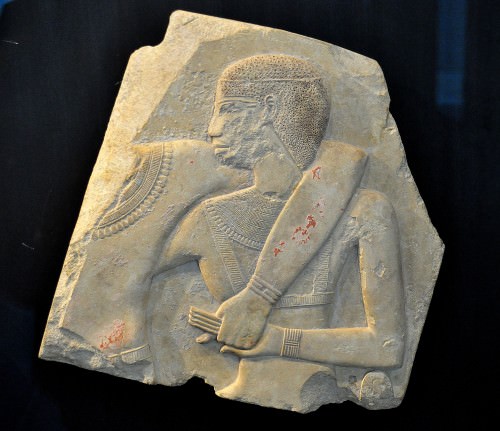
Mentuhotep II
Mentuhotep II's name is often substituted in translations (such as the one above) for the name Rahotep which appears in line III.6 when a translation is paginated, at the point where the ghost says, "When I was alive upon the earth, I was overseer of the treasury of King Rahotep". The ghost goes on to say, however, that he died in year 14 of the reign of Mentuhotep. This makes no sense as Rahotep (c. 1580-1576 BCE) was the first or second king of the 17th Dynasty while Mentuhotep reigned long before him as first king of the 11th Dynasty.
It is thought that the author may have confused the two kings since Rahotep, according to his stele at Coptos, was also associated with unifying the country under Thebes during the time of the Hyksos ' occupation of Lower Egypt. It may also have been that at the time of composition Rahotep's name was associated with the earlier hero's as a kind of 'second Mentuhotep' and audiences of the time would have understood the allusion. The actual name of the king is not as important as what that name would have signified to an audience: Nebusemekh was an important man closely associated with a great king and if his tomb could be allowed to fall into ruin so could anyone's. The details of the piece all go toward a single end of emphasizing the importance of respect for the dead and continual practice of the rites of remembrance.
LICENSE
Article based on information obtained from these sources:with permission from the Website Ancient History Encyclopedia
Content is available under License Creative Commons: Attribution-NonCommercial-ShareAlike 3.0 Unported. CC-BY-NC-SA License